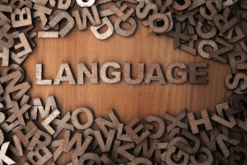Language as a Means of Self-Development
"Any help one can give the inarticulate child to become articulate is a defense of his life and dignity."
~Rosa Covington Packard

Self-development is often thought to be the conscious pursuit of personal growth. While that may often be true for many adults, there is a time in the life of a child where their selfdevelopment is housed in their 'unconscious absorbent mind' followed by their 'conscious absorbent mind.' Stop for a moment and consider how the infant learns to walk or express themselves with the spoken word. It is the unconscious absorbent mind at work. Next, pause for a moment and consider the four-year-old child that is learning to use a swing and the practice they consciously put into learning to pump their legs to move freely into the air. Both are examples of self-development. Let's take a look at a small sampling of the ways Dr. Maria Montessori inserted self-development and its refinement into our classrooms at Montessori Center of Our Lady.
Several games invented by Maria Montessori help prepare a child's ear for language. The silence games, in which a group of children is invited to relax and listen silently to the sounds around them and then, when asked, identify the sounds they heard. These games have a calming effect on the communication efforts of the nervous system. Another involves grading sound cylinders, which contain objects that make a series of loud and soft noises, or matching and grading bells from high to low pitch and help clarify the range of different auditory impulses. Games that isolate and allow a child to identify individual sounds of nature, noises of mechanical objects, tones of music, or syllables of speech help distinguish the variety of meanings in sounds.
In language development, adult examples are of great importance. Talking to a child is slow, quiet speech, using clear pronunciation, precise usage, and a varied choice of words is essential from birth, for the child absorbs the patterns and tonalities long before he can produce them. The adult who is aware of the movements of lips, tongue, breath, and jaws necessary to make sounds can give clear distinctions when necessary. The slight changes we make in one sound to create another are interesting to children. For instance, the sound of "H" is produced by breathing out without puffing the cheeks, and the sound of "W" is made without blowing, but the sound of "WH" is made while both blowing out and puffing the cheeks.
Children love to experiment with language. Since their vocabulary and their ability to organize words are often less developed than their understanding and desire to communicate, they can be very original in making their small means fit their larger ends, creating new words and new arrangements of words. As adults, we introduce children to the conventionally acceptable standard of articulate language.
"Language is the most powerful instrument of human development." ~ Dr. Maria Montessori
Young children have a hunger to learn more words and to classify the ones they already know. Edouard Sequin's three-period lesson is our point of departure-
• First period: one absorbs knowledge, is exposed to it, watches someone else show how to do it, and develops a rough idea. Labels are given.
• Second period: repetition continues with the newfound knowledge, uses it with gradual improvement, but without describing what one is doing, experiments, changes, and in doing so develops adequacy. We call this period the "show me stage."
• Third period: one can tell what one knows, use it creatively, accurately, and quickly, and can teach it to others. "What is this?" is not so much a test as understanding revealed. The remarkable thing about the third stage is that it not only means actual competence in the skill at hand but usually, it also means freedom to learn or act on a more advanced level. The third stage is a beginning as well as an end. For example: knowing the name of a specific animal frees you to learn more about that animal.
It is the role that a word plays that defines its part of speech in an expressed thought, not the word itself. A mop is a noun in "The mop hangs on the hook." A mop is a verb in "Mop the floor." The functional role of the various parts of speech and the symbols Dr. Montessori assigned to them are:
• A noun names. It is represented by a large black equilateral triangle.
• An article tells if it is any of them or all of them. It is represented by a small light blue equilateral triangle.
• An adjective tells what kind. It is represented by a small bright blue equilateral triangle.
• Conjunction joins. It is represented by a pink bar.
• A verb does. It is represented by a large red circle.
• An adverb tells how. It is represented by a small orange circle.
• A preposition tells where. It is represented by a green crescent.
• A pronoun tells the gender and number instead of naming. It is represented by a purple isosceles triangle.
Understanding these roles is a conceptual understanding, not a process of memorizing a verbalization of their definitions.
In short, life is often more enjoyable when patterns emerge. It is not necessary to know all the patterns of the English language yourself. What is needed is to initiate children into a treasure hunt to find patterns. If you show them patterns, they will know that patterns exist. When you give them opportunities to see other patterns for themselves, they may share their discoveries with you with great joy! Give it a try and enjoy the process together!
